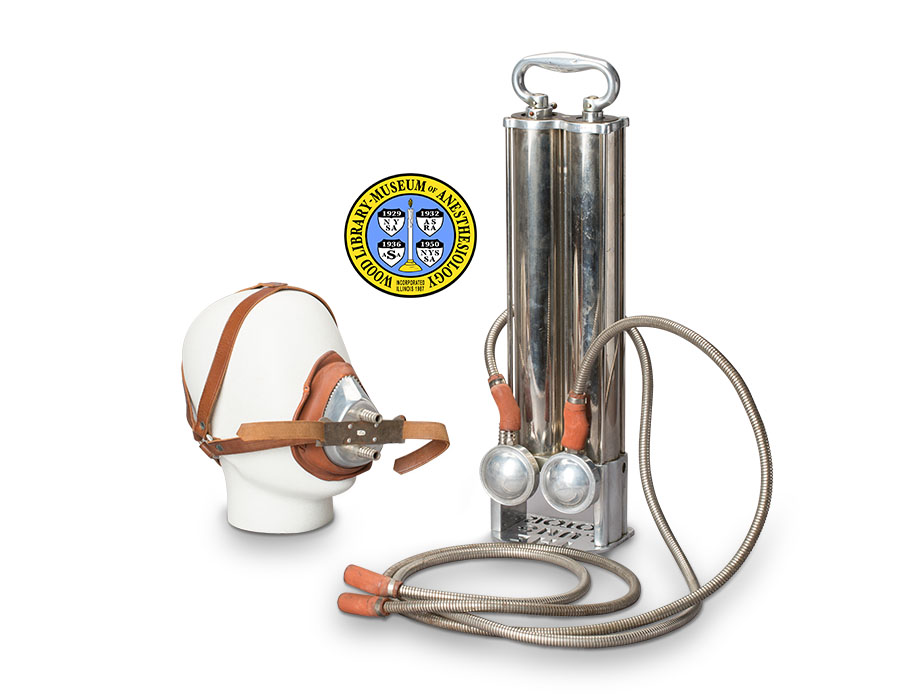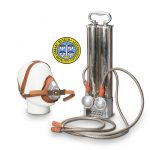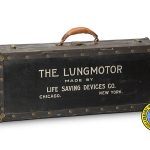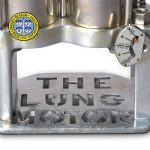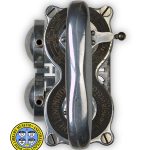Adult Lungmotor
Resuscitators are used to assist people with breathing difficulties, as well as victims of gas or smoke inhalation and other accidents. The chemist, inventor and entrepreneur George Poe (1846-1914) produced nitrous oxide for S. S. White before founding his own company to manufacture the gas. Prompted by the dangers of this industry, he obtained patents for an artificial respiration machine in 1907. He sold these rights to Frank T. Fowler, a Chicago businessman, in 1912. Within a year Fowler had obtained a patent for a further development of Poe's apparatus, called the Lungmotor. This name imitated that of the well-known Draeger Pulmotor. Fowler may also have founded the Life Saving Devices Co., which manufactured both this model and the Infant Lungmotor. These were heavily advertised from 1913 into the 1920s, and were purchased by numerous public works and fire departments, hospitals and mining companies.
Unlike the Pulmotor, the Lungmotor was hand-operated. Pushing the handle down forced air, oxygen, or a combination of the two, into the victim's lungs. Raising the handle suctioned the air out again. Although the apparatus could be adjusted to limit the pressure applied, investigators judged it to be safe only in the hands of experts. But the first responders who used it were rarely experts. In the 1930 movie, Soup To Nuts, the comedy trio later known as The Three Stooges exemplify the wrong way to use a Lungmotor.
Catalog Record: Adult Lungmotor Adult Lungmotor
Access Key: amyc
Accession No.: 66-111
Title: The Lungmotor / Life Saving Devices Co.
Corporate Author: Life Saving Devices Co.
Title variation: Alt Title
Title: The Lung Motor.
Publisher: [Chicago] : Life Saving Devices Co., [1915-1930?].
Physical Description: 1 resuscitation apparatus : metals, rubber; 86.5 x 15.5 x 12 cm.
Subject: Resuscitation – instrumentation.
Subject: Respiration, Artificial – instrumentation.
Subject: Ventilation, Mechanical.
Subject: Ventilators, Mechanical.
Note Type: General
Notes: The title is taken from the manufacturer’s label on the apparatus. In the base of the unit, the name appears as “The Lung Motor”. The first year in the date range is that of the earliest publications in which the cataloger found examples of the same design as the cataloged object. The second year in the date range is based on the date of the latest publication in which the cataloger found the company listed.
Note Type: With
Notes: One carrying case : wood, leatherette, felt, metals; Due to its fragility, this case was not photographed; Metal corner protectors on the exterior; The interior is divided into compartments and lined in blue velvet; The front of the case is marked in white paint: “THE LUNGMOTOR [new line] MADE BY THE [new line] LUNGMOTOR CORP. [new line] CAMBRIDGE, MASS. CHICAGO, ILL”.
Note Type: With
Notes: One face mask : metals, rubber ; 8 x 11 x 14 cm.; Two upright ports on the upper surface of the mask are meant to connect with hoses leading to the apparatus; Between these two ports, a metal crossbar is meant to hold the ends of a harness; The number “66-111 A” has been painted on the crossbar; The red rubber rim is brittle, has lost its inflation valve, and is otherwise deformed and torn.
Note Type: With
Notes: One mask harness : leather, metals ; 16 x 20 x 48 cm.; Consists of five leather straps, two metal rings, and metal grommets; The two rings are situated one on either side of the wearer’s head, close to the ears; One strap goes over the crown of the head, and the ends are attached to the rings by grommets; The second strap goes around the back of the head, and the ends are attached to the rings by grommets; The third strap rests vertically on the back of the head, connecting the first and second straps by means of grommets; the fourth and the fifth strap each lead forward from one of the rings, and their opposite, loose ends can be threaded through the crossbar on the mask.
Note Type: With
Notes: Other items inside the case include a cylinder yoke (painted accession number “66-111 D”). a double-ring tongue forceps (painted accession number “66-111 E”) and a pair of coiled metal hoses (painted accession number “66-111 G”); These were not photographed.
Note Type: Citation
Notes: ‘Lungmotor’ is new resuscitation device. The Gas Record. March 25, 1913;2(6):309-310.
Note Type: Citation
Notes: Hall JW. An artificial respirator. Scientific American. June 22, 1907;96(25):515.
Note Type: Citation
Notes: Lifesaving Devices company file. Located at: Wood Library-Museum of Anesthesiology, Schaumburg, Illinois.
Note Type: Citation
Notes: Mayer GM, Fowler FT, inventors. Resuscitating appliance. US Patent 1,157,655. October 19, 1915.
Note Type: Citation
Notes: Meltzer SJ. “History and Analysis of the Methods of Resuscitation.” Medical Record. July 7, 1917;92(1):1-10.
Note Type: Citation
Notes: Poe G, inventor. Resuscitating appliance. US Patent 859,778. July 9, 1907.
Note Type: Citation
Notes: Poe G, inventor. Machine for inducing artificial respiration. Canadian Patent 106,930. August 13, 1907.
Note Type: Citation
Notes: Talbot WW, inventor. Gas-generator. US Patent 1,212,281. January 16, 1917.
Note Type: Citation
Notes: Poe’s chemical works. Trenton Times. August 17, 1883. https://commons.wikimedia.org/wiki/File:Poe_Trenton_Times,_The_(Trenton,_New_Jersey)_1883_August_17_(cropped).gif. Accessed September 13, 2016.
Note Type: Citation
Notes: United States. Coast Guard. Annual Report of the United States Coast Guard for the Fiscal Year Ended June 30, 1915. Washington, DC: Government Printing Office, 1915:303. https://babel.hathitrust.org/cgi/pt?id=uc1.b5353548;view=1up;seq=329. Accessed September 8, 2016.
Note Type: Citation
Notes: United States. Public Health Service. Annual Report of the Surgeon General of the Public Health Service of the United States for the Fiscal Year 1915. Washington, DC: Government Printing Office, 1915:57. https://babel.hathitrust.org/cgi/pt?id=umn.31951d001165553;view=1up;seq=63. Accessed September 8, 2016.
Note Type: Physical Description
Notes: The front of the apparatus is that side to which the hoses attach, facing the patient, while the back is that side on which the gas control valve is mounted; All text, on the base, control valve and label, is meant to be read from the back of the apparatus, whereas if viewed from the front it appears upside-down; The highest point on the apparatus is the crown of the handle; The body of the apparatus consists primarily of two cylinders, set in a frame with a flat base, and with a handle rising above the frame; The handle can be moved with an action like that of a bicycle pump; The handle is attached to two hollow tubes, called pistons by the manufacturer; On the front of the apparatus, a dome-shaped regulator is affixed below each cylinder; That on the user’s right is the inspiration regulator and that on the user’s left is the expiration regulator; Each regulator can be unscrewed from the frame to provide access to the ball valve, also called a mixing valve, inside it; The pistons are deployed within the cylinders by moving the handle; When the handle is pushed down, the piston on the user’s right forces air and/or oxygen into the patient’s lungs; When the handle is pulled upwards, the piston on the user’s left creates suction, pulling air out of the patient’s lungs;
Due to the condition of the hoses, the measured width and depth of the unit refer only to the body of the apparatus and exclude component parts; The measured height is that with the handle at the fullest extension that was possible without forcing it; At that height, only five of the six holes which limit the application of pressure are exposed; When the handle is fully depressed the height is 55 centimeters;
The edge of the top of the frame, facing front, is stamped with the number “3143”; A label plate, in the shape of two adjacent circles, is screwed to the top of the frame; The circle on the left reads: “THE LUNGMOTOR [new line] U. S. AND FOREIGN PATENTS [new line] OTHER PATENTS PENDING [new line] MANUFACTURED BY [new line] LIFE SAVING DEVICES CO. [new line] CHICAGO; The circle on the right has three concentric rings, each marked with six control settings; The inner (or top) ring is marked, from right to left: “SIZE OF SUBJECT, INFANT, 5/YR., 10/YR, 15/YR, ADLT/AV, ADLT/LGE.”; The middle ring is marked, from right to left: “STROKES P. M., 60, 26, 20, 20, 18, 18”; The outer (or bottom) ring is marked, from right to left: “CU. IN. PER STROKE, 5.25, 12.25, 18.88, 27.50, 35.43, 45.06”; The word “STOP” is perpendicular to these concentric rings, to the left of the words “Size”, “Strokes” and “Cu. In.”;
When read from top to bottom, all of these markings form groups that pertain to patients of each size; The infant control setting permits the least extension of the pistons (approximately 3.5 centimeters above the top of the frame), delivers the least volume (5.25 cubic inches per stroke) and requires 60 strokes per minute; The large adult setting permits the fullest extension of the pistons, delivers the greatest volume (45.06 cubic inches per stroke), and requires 18 strokes per minute;
Note Type: Physical Description
Notes: The piston on the user’s right has a series of six holes along its length, each of which can be engaged by means of the volume regulator that is mounted on this piston, directly above the label plate; This regulator has a red pointer on one side of the piston and a pin, called a setpin by the manufacturer, on the other side; By pulling on the pin, the regulator is freed from its position and can be swiveled fully around the piston; When the pointer aligns with the desired setting, the pin can be pushed back into position to lock the setting; Painted on this cylinder, at the foot of the cylinder, is the WLM accession number “66-111”;
Mounted on the frame, above and to the right of the inspiration regulator, is a port to which a source of oxygen can be connected; The same port can be used to draw in fluids used to clean the apparatus; Mounted on the back of the frame, opposite the oxygen port and facing the user, is a roughly triangular or fan-shaped gas control dial, which pivots around a short rod; This rod extends from the back of the unit through a crescent-shaped opening in the dial; A plate bearing the gas control settings is riveted to the dial; This plate is marked, from top to bottom: “ALL AIR [new line] 1/2 OXY. 1/2 AIR [new line] ALL OXYGEN”; To select one of these settings, the markings on the dial must be aligned with the rod; The narrow end of the dial is stamped with the number “16”;
The words “THE [new line] LUNG [new line] MOTOR” are cut into the flat base of the unit, the letters being formed by a stencil;
Component parts of the apparatus include two hoses made of flexible coiled metal; Each hose is approximately 185.5 centimeters long and 1.5 centimeters in diameter; Each hose has a red rubber connector at each end; Each connector is approximately 5 centimeters in length and 2.5 centimeters in diameter; One end of each hose is meant to be attached to one of the two regulator valves, and the other end is meant to be attached to one of two ports built into an associated face mask; The connectors have become stiff and brittle, and can no longer be fitted to the associated mask; This condition makes the total length (or depth) of the apparatus difficult to estimate.
Note Type: Reproduction
Notes: Photographed by Mr. Steve Donisch, January 12, 2016.
Note Type: Historical
Notes: Resuscitators are used to assist people with breathing difficulties, as well as victims of gas or smoke inhalation and other accidents. Anesthesiologists are responsible for resuscitating patients if that is needed during surgery. The chemist, inventor and entrepreneur George Poe (1846-1914) produced nitrous oxide for the S. S. White Dental Manufacturing Company for some years. Then, around 1883, he founded a competing nitrous oxide manufactory, the Poe Chemical Works, in Trenton, New Jersey. Prompted by the dangers of this industry, he invented a resuscitator that delivered oxygen, which he began to promote in 1889. He obtained patents, in the United States and Canada, for an artificial respiration machine in 1907.
He sold these patent rights to Chicago businessman Frank T. Fowler in 1912 (Gas Record, p. 309.) In April, 1913 Fowler launched an intensive sales campaign for a further development of Poe’s apparatus, called the Lungmotor. That same month, he applied to patent this apparatus; the patent was granted more than two years later. The Lungmotor was heavily advertised in newspapers and popular magazines, as well as industrial and medical journals. It was purchased by public works departments, fire departments, hospitals, and companies in the electrical, gas and coal industries. The pediatric model, called the Infant Lungmotor, was not as widely advertised.
Fowler may also have founded the Life Saving Devices Company, sole manufacturer of the Lungmotor. The company was chartered in the State of Delaware in 1913, and had its main office in Chicago. By 1915, branch offices had been opened in New York City and Boston. Advertisements and other references to either the company or the apparatus fall away sharply after 1918 and continue with decreasing frequency into the mid-1920s. The cataloger was unable to determine when production ceased.
The Lungmotor was probably named in imitation of the well-known Draeger Pulmotor, which was introduced in the same year as Poe’s apparatus. It has also been likened to the Courtois resuscitation apparatus, which had been described more than a century earlier (Meltzer, p. 3.) The Lungmotor was sold in a case that included hoses, masks, tracheal tubes, mouth gags and a tongue forceps. As early as 1913, it could also be purchased together with an oxygen generator. In 1917, the patent for a gas generator was assigned to Mr. Fowler by the inventor, William W. Talbot. That design bears a strong resemblance to the Foregger Autogenor.
The Lungmotor has controls to limit the volume of gas and/or air that can be delivered, with six settings for patients ranging in size from infants to large adults. But investigators for the U. S. Bureau of Mines (Surgeon General’s report), the U. S. Coast Guard, and the Rockefeller Institute for Medical Research (Meltzer), judged the powerful suction created by the apparatus to be unsafe, except in the hands of experts. The cataloged example was photographed together with a carrying case that is associated with a different example of the apparatus.
Note Type: Exhibition
Notes: Selected for the WLM website. For purposes of photography, married to the hoses from that Lungmotor which has been given WLM 2013 Serial No. 2011 (this example has no accession number.)
Access Key: andf
Accession No.: 1947-02-01-1
Title: [Lungmotor carrying case] / Life Saving Devices Co.
Corporate Author: Life Saving Devices Co.
Publisher: Chicago : Life Saving Devices Co., [1913-1930?].
Physical Description: 1 carrying case : Wood, leatherette, metals, felt; 30 x 59 x 15 cm.
Subject: Resuscitation – instrumentation.
Subject: Respiration, Artificial – instrumentation.
Subject: Ventilators, Mechanical.
Subject: Ventilation, Mechanical.
Note Type: General
Notes: The title is taken from the manufacturer’s marks on the case. The first year in the date range is that of the earliest publications in which the Lungmotor apparatus was found. It is likely to have been made somewhat later; by 1915, the company had branches in New York and Boston. The second year in the date range is based on the date of the latest publication in which the cataloger found the company listed.
Note Type: With
Notes: The contents of the case include an adult Lungmotor apparatus, a pair of coiled metal hoses (each with a black rubber connector at either end), and a face-mask; These were not photographed.
Note Type: Citation
Notes: ‘Lungmotor’ is new resuscitation device. The Gas Record. March 25, 1913;2(6):309-310.
Note Type: Citation
Notes: Hall JW. An artificial respirator. Scientific American. June 22, 1907;96(25):515.
Note Type: Citation
Notes: Life Saving Devices Company file. Archives. Located at: Wood Library-Museum of Anesthesiology, Schaumburg, Illinois.
Note Type: Physical Description
Notes: One carrying case; The dimensions given are those with the lid closed and the case standing on its bottom edge, with the handle fully extended; When the case is lying on its back with the open lid standing upright, the height is 34.5 centimeters; When the case is lying on its back with the lid fully opened, the depth is 52 centimeters; The case has three metal clasps on the top edge; The interior is divided into several compartments, and is lined in purple felt; The leather grip of the handle is much deteriorated; Both the front and back of the case are marked in silver paint: “THE LUNGMOTOR [new line] MADE BY [new line] LIFE SAVING DEVICES CO. [new line] CHICAGO NEW YORK”.
Note Type: Reproduction
Notes: Photographed by Mr. Steve Donisch, January 12, 2016.
Note Type: Historical
Notes: Resuscitators are used to assist people with breathing difficulties, as well as victims of gas or smoke inhalation and other accidents. Anesthesiologists are responsible for resuscitating patients if that is needed during surgery. The chemist, inventor and entrepreneur George Poe (1846-1914) produced nitrous oxide for the S. S. White Dental Manufacturing Company for some years. Then, around 1883, he founded a competing nitrous oxide manufactory, the Poe Chemical Works, in Trenton, New Jersey. Prompted by the dangers of this industry, he invented a resuscitator that delivered oxygen, which he began to promote in 1889. He obtained patents, in the United States and Canada, for an artificial respiration machine in 1907.
He sold these patent rights to Chicago businessman Frank T. Fowler in 1912 (Gas Record, p. 309.) In April, 1913 Fowler launched an intensive sales campaign for a further development of Poe’s apparatus, called the Lungmotor. That same month, he applied to patent this apparatus; the patent was granted more than two years later. The Lungmotor was heavily advertised in newspapers and popular magazines, as well as industrial and medical journals. It was purchased by public works departments, fire departments, hospitals, and companies in the electrical, gas and coal industries. The pediatric model, called the Infant Lungmotor, was not as widely advertised.
Fowler may also have founded the Life Saving Devices Company, sole manufacturer of the Lungmotor. The company was chartered in the State of Delaware in 1913, and had its main office in Chicago. By 1915, branch offices had been opened in New York City and Boston. Advertisements and other references to either the company or the apparatus fall away sharply after 1918 and continue with decreasing frequency into the mid-1920s. The cataloger was unable to determine when production ceased.
The Lungmotor was probably named in imitation of the well-known Draeger Pulmotor, which was introduced in the same year as Poe’s apparatus. It has also been likened to the Courtois resuscitation apparatus, which had been described more than a century earlier (Meltzer, p. 3.) The Lungmotor was sold in a case that included hoses, masks, tracheal tubes, mouth gags and a tongue forceps. As early as 1913, it could also be purchased together with an oxygen generator. In 1917, the patent for a gas generator was assigned to Mr. Fowler by the inventor, William W. Talbot. That design bears a strong resemblance to the Foregger Autogenor.
The Lungmotor has controls to limit the volume of gas and/or air that can be delivered, with six settings for patients ranging in size from infants to large adults. But investigators for the U. S. Bureau of Mines (Surgeon General’s report), the U. S. Coast Guard, and the Rockefeller Institute for Medical Research (Meltzer), judged the powerful suction created by the apparatus to be unsafe, except in the hands of experts. The cataloged example was photographed together with a carrying case that is associated with a different example of the apparatus.
Note Type: Exhibition
Notes: Accession number refers to the entire apparatus and its carrying case. Carrying case only selected for the WLM website.
